Choosing the wrong excavator types and sizes can lead to increased costs, project delays, and reduced productivity on the job site. It is important to carefully consider the specific job requirements, material types, work environment, and job site conditions when deciding on which excavator to use.
Many guys, especially with complex or diverse job sites, try to operate with underpowered mini’s or oversized machines that tear up the terrain, burn a bunch of fuel and can actually turn a slowdown of workflow into a safety and efficiency issue. They could probably do a lot better on their jobsite and project if they had the right size machine.
Once you understand the standard sizes and types of excavators, you can match them up to specific construction needs. In this article, we’ll break down the types of excavators by class, from mini to large, and show you the benefits and drawbacks of each.
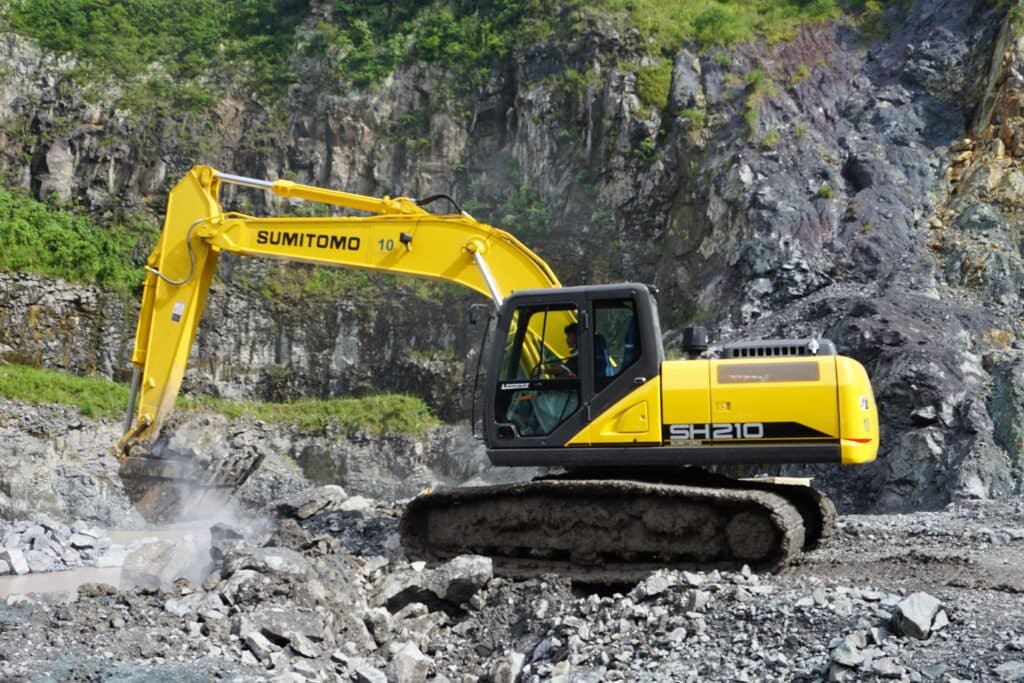
🔄 How Excavator Types Directly Influence Efficiency
1. Mini Excavators – Compact Size for Precision Work
Do you need an excavator for a tight urban space, small-scale construction, or landscaping job? A mini excavator works best in that scenario. This tiny machine with a compact frame allows you to access places a larger machine can’t reach.
| Spezifikation | Typical Range |
|---|
| Betriebsgewicht | 0.8 – 6 tons |
| Tiefe graben | 1.5 – 4 meters |
| Pferdestärken | 10 – 40 HP |
Anwendungen
- Backyard landscaping: involves transforming outdoor spaces using machinery like mini excavators for digging, leveling, and shaping the terrain. It’s ideal for creating gardens, patios, ponds, or walkways efficiently and precisely.
- Residential pipe trenching: involves digging narrow trenches for installing water, gas, or drainage pipes around homes. Mini excavators with trenching buckets are commonly used for precise, efficient, and clean digging.
- Indoor demolition: involves removing interior walls, flooring, or structures within buildings. Compact excavators or hydraulic breakers are used for controlled, efficient work in confined spaces with minimal disruption.
- Utility installations: involve digging and preparing underground spaces for water, gas, electric, or telecom lines. Excavators with trenching or digging buckets ensure accurate and efficient installation in residential or commercial areas.
Performance Impact
✅ Minimal ground damage
✅ Easy transportation
✅ Cost-effective for short-term tasks
❌ Limited lifting/digging capacity
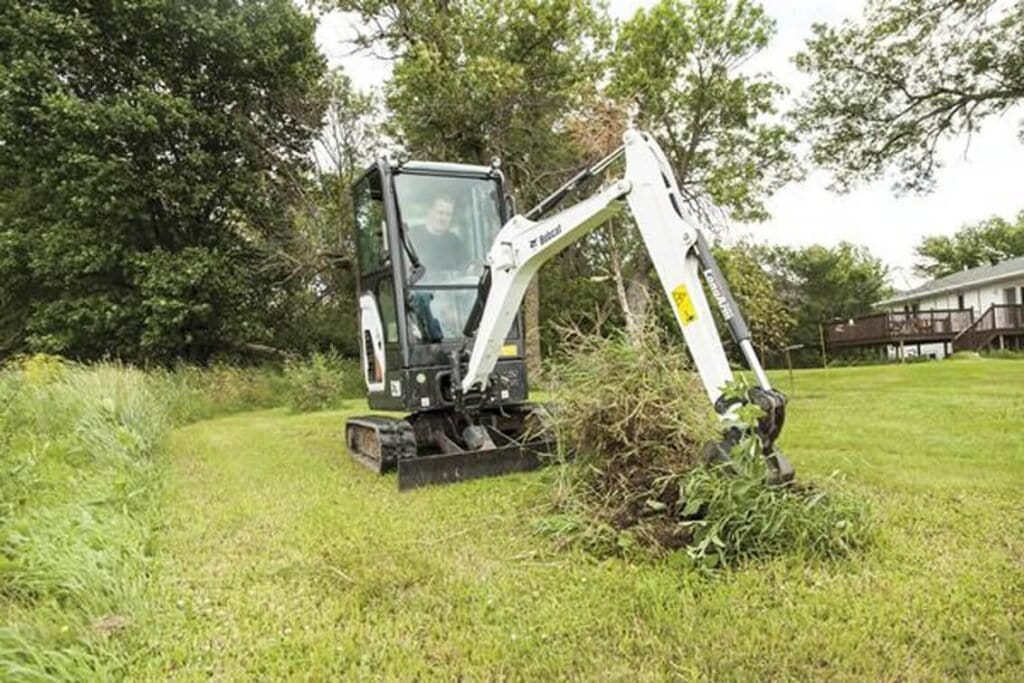
2. Midi Excavators – Balanced for Urban Construction
Midi excavators fit nicely between a mini and a standard-sized excavator. They usually come into play in urban developments where you need more power than a mini can offer but more maneuverability and versatility than a big machine.
| Spezifikation | Typical Range |
|---|
| Betriebsgewicht | 6 – 10 tons |
| Tiefe graben | 3.5 – 5.5 meters |
| Pferdestärken | 40 – 70 HP |
Anwendungen
- Residential foundation digging: involves excavating soil to prepare a stable base for home construction. Mini or medium excavators are commonly used for precise digging, ensuring proper depth, alignment, and structural support.
- Roadside trenching: involves digging narrow trenches alongside roads for utilities like cables, drainage, or pipelines. Excavators with trenching buckets provide efficient, precise cutting in limited roadside spaces.
- Sewer and drainage repair: involves excavating around damaged pipelines to access, replace, or fix underground systems. Excavators ensure quick, accurate digging, minimizing disruption to surrounding areas.
Performance Impact
✅ Greater lifting capacity than minis
✅ Suitable for urban environments
✅ Reduced tail swing improves mobility
❌ Higher fuel consumption than mini excavators
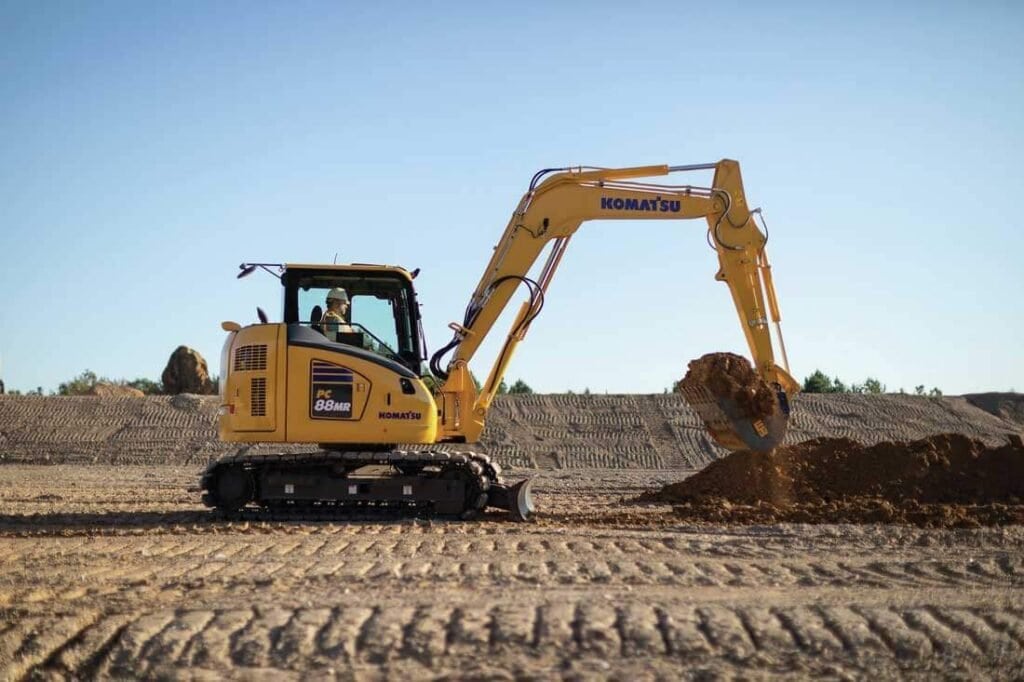
3. Standard Excavators – The Construction All-Rounders
Standard, or full-size, excavators are the workhorse on most medium-to-large scale construction sites.
| Spezifikation | Typical Range |
|---|
| Betriebsgewicht | 10 – 25 tons |
| Tiefe graben | 5 – 7 meters |
| Pferdestärken | 70 – 200 HP |
Anwendungen
- Road and bridge building: involves large-scale excavation, grading, material handling, and compaction. Excavators, loaders, and compactors play key roles in foundation work, structure support, and surface preparation.
- Commercial foundations: involves excavating large areas for building foundations. Excavators are used for precise digging, leveling, and removing soil, ensuring a solid base for commercial structures like offices, malls, or warehouses.
- Bulk material movement: involves transporting large quantities of materials like gravel, sand, or soil on construction sites. Excavators, loaders, and trucks are used to efficiently move and distribute materials for various projects.
Performance Impact
✅ High productivity
✅ Wide attachment compatibility
✅ Efficient in most soil conditions
❌ Not suitable for narrow spaces
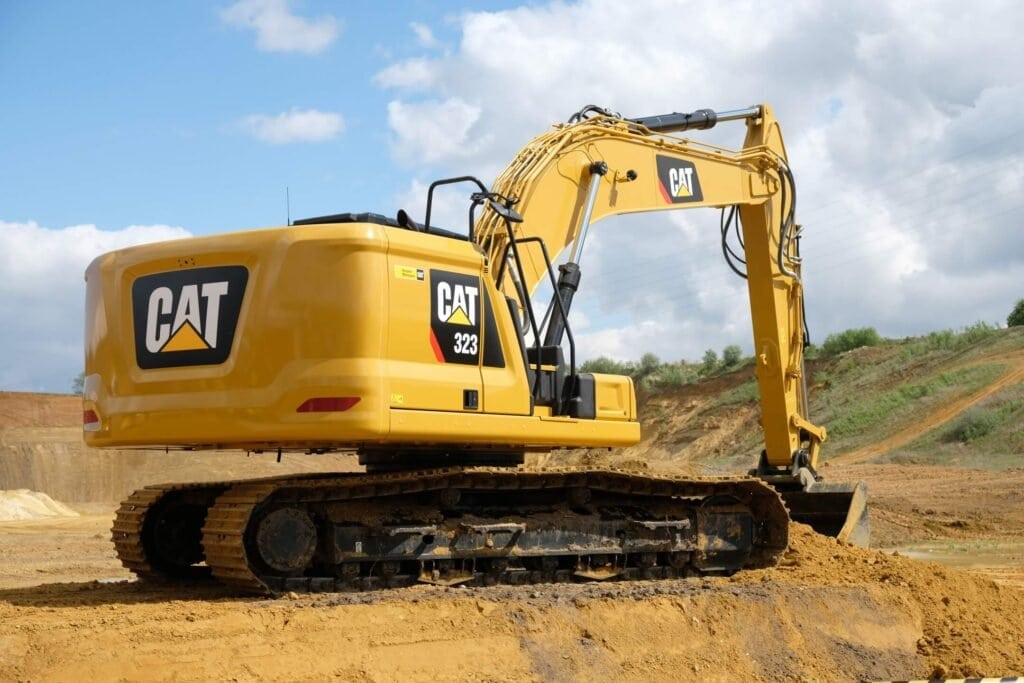
4. Large Excavators – Built for Heavy-Duty Operations
Large excavators are for the big boys who work in all the harshest environments. The sheer power and reach make large excavators a go-to in mining, quarrying, and large infrastructure development.
| Spezifikation | Typical Range |
|---|
| Betriebsgewicht | 25 – 90 tons |
| Tiefe graben | 7 – 12 meters |
| Pferdestärken | 200 – 500+ HP |
Anwendungen
- Open-pit mining: involves excavating minerals or ores from the earth’s surface through a large, stepped excavation. Excavators, dump trucks, and loaders are used to remove material efficiently and safely in mining operations.
- Large foundation digging: involves excavating substantial areas for building foundations, typically for commercial or industrial structures. Excavators and heavy-duty machinery are used to dig deep and wide, ensuring a solid and level base for construction.
- Rock and earth removal: involves using heavy machinery, such as excavators and breakers, to clear rock and soil for construction or mining projects. This process ensures a smooth, stable surface for further construction work.
Performance Impact
✅ Maximum digging capacity
✅ Best suited for deep or wide excavation
✅ Supports the heaviest attachments
❌ High fuel consumption and transport complexity

5. Wheeled Excavators – Mobility Meets Versatility
Wheeled excavators give you speed and mobility, making them perfect for roadwork or when working on a paved (or compacted) surface.
| Spezifikation | Typical Range |
|---|
| Betriebsgewicht | 10 – 20 tons |
| Reisegeschwindigkeit | 20 – 40 km/h |
| Tiefe graben | Up to 5.5 meters |
Anwendungen
- Road construction:involves excavating, grading, and compacting soil to create a stable foundation, followed by paving with asphalt or concrete. Excavators, bulldozers, and graders are commonly used to ensure proper alignment and durability of the road.
- Municipal work: includes infrastructure projects like road construction, sewer installation, and utility repairs. Excavators, loaders, and trenchers are often used to dig, transport, and install essential services in urban areas.
- Material handling in urban zones: involves transporting and managing construction materials in densely populated areas. Excavators, loaders, and cranes are used to efficiently move materials while minimizing disruption to traffic and surrounding structures.
Performance Impact
✅ High mobility
✅ Less surface damage
✅ Fast site-to-site transport
❌ Less stable on uneven terrain

6. Long Reach Excavators – Specialized for Depth & Distance
Long reach excavators are just what they sound like, excavators with extended arms to reach areas other machines can’t. You see long reach excavators in use for things like reaching out over a riverbank or digging out the foundation for a giant building.
| Spezifikation | Typical Range |
|---|
| Betriebsgewicht | 20 – 45 tons |
| Max Reach | 15 – 25 meters |
| Pferdestärken | 100 – 300 HP |
Anwendungen
- Canal and dredging operations: involve clearing and deepening waterways to improve navigation or water flow. Excavators, dredgers, and specialized equipment are used to remove sediment, rock, and debris from the bottom of canals or rivers.
- Slope grading: involves shaping and leveling land to create stable, sloped surfaces for construction or landscaping. Excavators and graders are used to ensure proper drainage and prevent erosion by creating consistent, controlled slopes.
- Deep trench excavation: involves digging large, deep trenches for utilities, foundations, or drainage systems. Excavators with trenching buckets are commonly used for precision, ensuring safety and efficient removal of soil in confined spaces.
Performance Impact
✅ Excellent for specialized digging
✅ Reduces need for repositioning
✅ Ideal for aquatic construction
❌ Not suitable for confined job sites
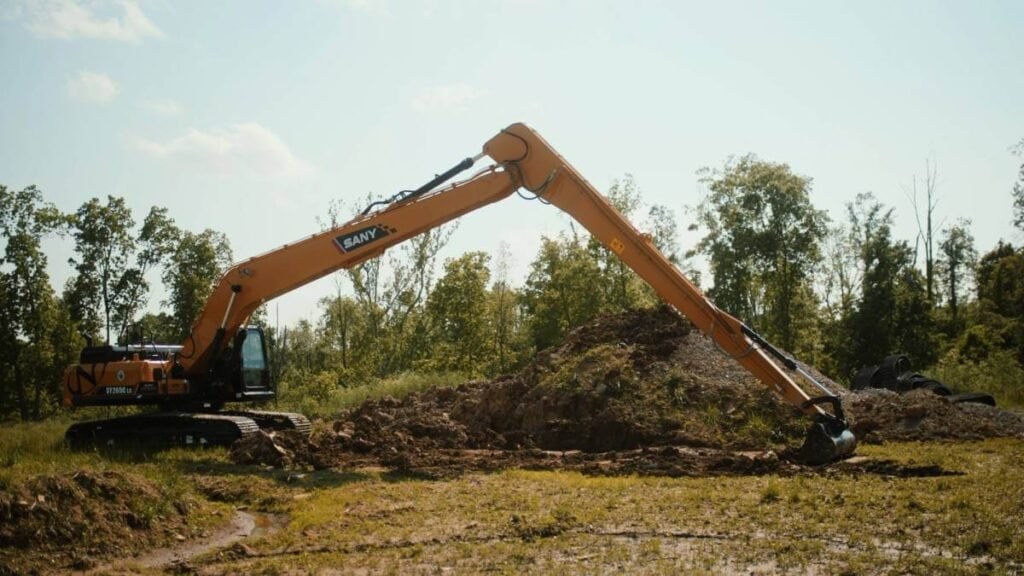
🔍 How Size Influences Site Performance and Costs
| Factor | Small Excavator (0–6 tons) | Medium Excavator (6–25 tons) | Large Excavator (25+ tons) |
|---|
| Site Accessibility | Excellent | Mäßig | Poor |
| Kraftstoffverbrauch | Niedrig | Medium | Hoch |
| Transport Requirements | Minimal | Trailer Required | Special Transport |
| Digging Force | Niedrig | Mäßig | Hoch |
| Operator Skill Level | Beginner-Friendly | Intermediate | Expert |
| Attachment Compatibility | Limited | Broad | Extensive |
| Ideal Use Cases | Landscaping, utility work | Commercial projects, roads | Mining, large infrastructure |

🛠 Excavator Attachments and Their Role in Job Performance
Excavator productivity isn’t just about size—it’s about tool versatility. Here are key attachments that influence job efficiency:
| Attachment | Bester Anwendungsfall | Size Compatibility |
|---|
| Standard Bucket | General digging | All sizes |
| Tilt Bucket | Slope shaping | Mini to large |
| Hydraulic Breaker | Demolition | Medium to large |
| Greifen | Waste handling | Midi to large |
| Auger | Post hole digging | Mini to medium |
| Ripper | Frozen ground | Medium to large |
🏗 Real-World Scenarios: Excavator Type in Action
Case 1: Urban Landscaping Project
In a compact residential area located in central Jakarta, a landscaping contractor was tasked with redesigning a private courtyard that required digging shallow drainage lines, shaping garden contours, and installing small retaining walls. The worksite was highly restrictive — only 1.6 meters of clearance at the entrance and surrounding concrete structures limited maneuverability.
Machine Deployed: 2-ton mini excavator
Attachment Used: Hydraulic tilt bucket
Job Duration: 4 working days
The 2-ton mini excavator was chosen specifically for its compact dimensions, lightweight design, and ease of operation. Its zero-tail swing allowed the operator to work near walls without risking damage, and the rubber tracks prevented surface scratches on tiled walkways. The hydraulic tilt bucket proved essential in grading subtle slopes and fine contours required for water drainage and aesthetic landscaping.
Performance Outcome:
- ✅ Zero impact on existing infrastructure
- ✅ Completed 2 days ahead of projected timeline
- ✅ Reduced manual labor by 70%
- ❌ Limited reach required multiple machine repositionings
Case 2: Rural Road Expansion
A mid-scale contractor in northern Chile was awarded a 1.2 km road widening project through semi-rural terrain. The goal was to expand a narrow gravel road to accommodate two-way traffic, requiring grading, trench excavation for drainage, and some rock-breaking tasks along the shoulder.
Machine Deployed: 20-ton standard crawler excavator
Attachments Used: Grading blade & hydraulic breaker
Job Duration: 12 working days
The contractor selected a 20-ton crawler due to its power-to-weight ratio and compatibility with heavy-duty attachments. The grading blade leveled ground swiftly across large sections, while the breaker handled exposed bedrock zones without needing additional equipment. Its track system provided strong traction and terrain stability, which was crucial for the uneven, loose soil.
Performance Outcome:
- ✅ Achieved consistent daily production rate of 100 meters
- ✅ Reduced total equipment needs from 3 to 1 machine
- ✅ Improved budget efficiency by 18%
- ❌ Slower repositioning time across the site due to tracked system
Case 3: Riverbank Stabilization
A government environmental restoration project in Vietnam focused on strengthening 600 meters of eroding riverbank. The team had to remove silt and place large riprap stones without disturbing sensitive aquatic zones. The challenge was access—excavation needed to be done from a safe distance to prevent bank collapse and avoid damaging flora and fauna.
Machine Deployed: 40-ton long-reach excavator
Attachment Used: Clamshell bucket
Job Duration: 20 working days
The 40-ton long-reach machine offered an extended arm reach of over 20 meters, allowing precise material placement without driving equipment close to the edge. The clamshell bucket ensured firm grip and safe lifting of riprap stones. Despite its size, the operator reported excellent hydraulic precision, especially when positioning materials along slopes.
Performance Outcome:
- ✅ 100% safety record throughout the project
- ✅ Minimal disruption to surrounding wildlife and vegetation
- ✅ Efficient silt removal from deep pockets
- ❌ Required specialized transport and setup due to size

📊 Case Study Comparison Table
| Case | Baggertyp | Weight Class | Key Attachment | Environment | Performance Highlights |
|---|
| Urban Landscaping | Mini | 2 tons | Tilt bucket | Confined urban space | Fast completion, surface protection, high maneuverability |
| Rural Road Expansion | Standard crawler | 20 tons | Grading blade & breaker | Loose gravel, uneven | Versatility, reduced equipment count, efficient grading |
| Riverbank Stabilization | Long-reach excavator | 40 tons | Clamshell bucket | Wet, unstable slope | Max reach, safety compliance, effective stone placement |
📋 Expert Tips for Choosing the Right Baggertypen und Größen
- Define Your Job Scope First – Understand what materials you’re handling and how deep or far you need to dig.
- Evaluate Terrain Conditions – Consider whether wheeled or tracked is more suitable.
- Factor in Operating Costs – Larger machines deliver more power, but they come with higher fuel and transport costs.
- Check Attachment Needs – Choose an excavator that supports the tools your project requires.
- Look for Multi-Functionality – Mid-size excavators often provide the best balance of power, reach, and adaptability.
🧠 Conclusion – Right Excavator, Better Performance
Last but not least, your choice of excavator type and size is crucial to maximizing the performance of your job site. These principles apply whether you’re doing urban landscaping, heavy-duty mining, or small-town municipal roadworks. Matching the scale of your project to the size and type of the machine will get your job done faster, cheaper, and in a way safer for your operator. At HIOSEN, we have you completely covered with our wide selection of used excavators — from a tiny little compact mini to a heavy duty long reach machine, we’ve got exactly what you need every time.